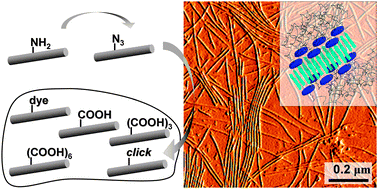Peptide–polymer nanotapes can be decorated with diverse functionalities thanks to a versatile strategy developed by scientists in Germany.
Hans Börner, at the Max Planck Institute of Colloids and Interfaces in Potsdam, and colleagues modified self-assembled nanotapes of poly(ethylene oxide)–peptide conjugates by a simple amine–azide transfer to create azide-containing nanofibres. Using click chemistry, they then introduced different carboxyl-bearing entities to modulate the calcium binding properties of the nanotapes.
To find out more, download Börner’s communication, which is free to access until 9th December.
Also of interest: Anti-wrinkle creams aided by nanotapes











